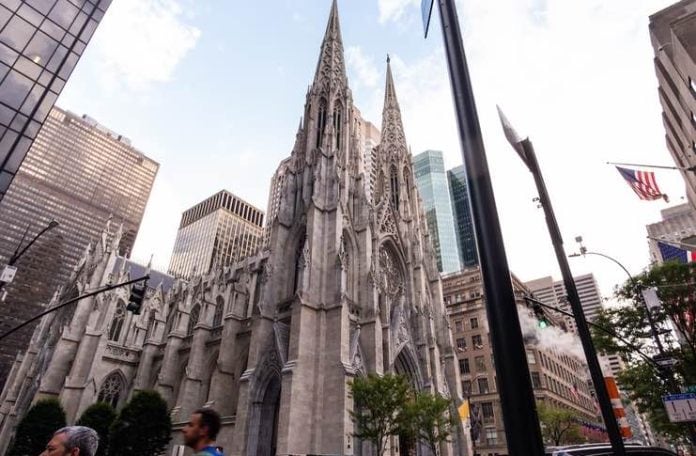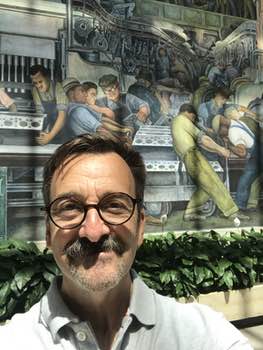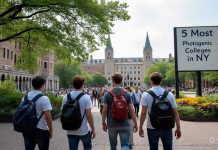
The churches of New York have loomed large in American history, hosting many significant events involving runaway slaves, George Washington, Boss Tweed, and strikers. Sometimes serving as hospitals, meeting houses, and museums, the following ten are the oldest churches in the city that deserve a visit.
1. New Lot Community Church (1824)
New Lots Community Church is located in the East New York neighborhood of Brooklyn. In 1823 the peasants of New Lot obtained permission to build their local church. Farmers did not have enough money to buy materials or hire builders, so they collected wood from the forest near their homes.
This process was facilitated by the fact that a hurricane destroyed many mighty oaks in the area two years earlier. The community saw these fallen trees as a gift from God, which they gratefully accepted.
When the frame of the church was completed, the townspeople gathered to “raise the roof”. With the exception of the plasterwork, every part of the church was made by the local community it was supposed to serve.
It is a very simple structure with little ornamentation behind the Gothic-style arched windows. Built in 1824, this wooden building has survived to this day, which is a testament to the skill of the settlers. A must-see place can be visited by renting a New York church bus.
2. First Chinese Presbyterian Church (1817-19)
The building at 61 Henry Street first opened in 1819 as the Reformed Church on Market Street, boasting Gothic windows and doors that pre-date the Gothic Revival trend. The Dutch Reformed Church was dissolved in 1864 and in 1866, the church began its second life when the Church of the Sea and Land moved in.
Formed the year before, this Presbyterian congregation catered to sailors, former sailors, as well as their friends and families, lasting until 1972 when it was replaced by the First Chinese Presbyterian Church, which has been based there since 1951. By he way, if you come with a big church group and need a bus, BCS Bus Charter will easily take your group there.
3. St. Mark’s Cathedral in Bowery (1795-99)
The second-oldest church edifice in Manhattan is St. Mark’s-in-the-Bowery. Additionally, it is the church’s oldest still-standing location. For the exclusive use of his family, Governor Peter Stuyvesant built a tiny chapel in 1654.
Before granting it to Holy Trinity Church in 1793, the Stuyvesant family owned the chapel and the neighboring property for more than a century. The cornerstone for the new church was laid on Saint Mark’s Day in 1795.
Watch this video to learn more:
City Hall, which was finished in 1799, was designed by John McComb Jr., though the spire and porch were later additions. Alexander Hamilton assisted in the establishment of St. Mark’s as a stand-alone episcopal parish, despite the fact that Holy Trinity provided funding for the building of the cathedral. And that, in accordance with the charter from 1697, it was the sole parish church in New York. The church is still active today, and to get to it, you need to rent a church bus in New York City.
4. Episcopal Church of St. Augustine (1829)
In 1829, the Episcopal Church of St. Augustine was erected on Henry Street using Mount Pitt stone. The 3rd Bishop of New York blessed the church in 1828, even though construction on it did not end until 1829. The early 1960s saw the removal of the wooden bell tower that once topped the church tower, but the bell continued to function as the neighborhood’s fire alarm.
The secret slave galleries of St. Augustine Church are a significant part of its history. These two small, dark apartments can be found at the back of the balcony organ on both sides. Though slavery had mostly ended in the state by 1827, New York still acknowledged this status for those whose masters had come from elsewhere.
Watch this video to learn more:
Wanted man Boss Tweed even used one of the galleries to attend his mother’s funeral in 1876. Sunday school later replaced the galleries, but in order to honor those who had used it before, the church now holds art exhibits and tours.
5. Flatbush Reformed Church (1793-98)
One of the earliest churches on Long Island is in Brooklyn’s Flatbush district. The cross-shaped structure, built to deter Indian attacks, was replaced with a more modern building between 1793 and 1798. The new edifice incorporated the Manhattan slate from Hell Gate and reused stones from the original building for its foundation.
Buried beneath the cathedral are the graves of American soldiers who perished in the Battle of Long Island. The clock and bell tower of the church still display a Dutch design from 1796, and the bell may sound like the one for former U.S. Presidents and Vice Presidents when they pass away.
Watch this video:
6. St. Paul’s Chapel (1764-66)
St. Paul’s Chapel at 209 Broadway was built in 1766 to serve the expanding congregation of the parish of Holy Trinity Church on Wall Street. This is not only the oldest church in Manhattan, but also the oldest surviving public building in the city.
All of them can be found using the NY church bus rental service. The belfry of the church, which was added to the building in 1794, has two bells, the first of which was made in England in 1797. A second bell was added in 1866 to celebrate the centenary of the church.
Watch this video to learn more:
In the 1790s, when New York was the US capital, President George Washington visited St. Paul’s Chapel for prayer. Most of the original pews were removed and preserved after that time, apart from those reserved for Washington and the Governor, George Clinton. Years later, in the aftermath of the 9/11 terrorist attacks, the chapel provided rest and prayer for firefighters and rescue personnel.
7. Old Episcopal Church of St. Jacob (1735)
A mission church known as Old St. James Episcopal Church in Queens was constructed in 1735 on property donated by Newton, which would later become Elmhurst. ?hurch transportation in NYC will help you get there. Even though it was no longer in use on a regular basis, the old church was abandoned in 1849. It was accorded historic status in 2017. It is New York City’s second-oldest ecclesiastical structure.
Want to read more of our latest posts? Learn how to immerse yourself in Jewish Culture in NYC.

“The Jaded Traveler”. Ron Rossi was born and raised in New York. A globalist at heart, Ron is a marketing director by trade, and has lived and worked around the world including Asia, Europe, Africa, and South America. Food is one of the best ways to learn about a country, a people and a culture. So, Ron is always looking for the best in mid-range to budget and street food. He is always on the hunt for a good meal anyone can afford. It is the food of the average citizen that excites him. And with having visited close to 100 countries on 6 continents so far, there have been some pretty good meals.









 Sarah Knapp is a Brooklyn based entrepreneur whose love for the outdoors and community building led her to the October 2013 creation of OutdoorFest. She has a BA in History, is a Wilderness First Responder and a NY state hiking, camp and boating guide. Her proudest achievement to date is reading the Aeneid in Latin.
Sarah Knapp is a Brooklyn based entrepreneur whose love for the outdoors and community building led her to the October 2013 creation of OutdoorFest. She has a BA in History, is a Wilderness First Responder and a NY state hiking, camp and boating guide. Her proudest achievement to date is reading the Aeneid in Latin.  Allison was one of our first top writers and Chief Editor but is no longer working with offMetro. Allison is a native New Yorker, who has lived in Rome, Tuscany, Melbourne, Toronto and Los Angeles. She frequently contributed travel pieces to Family Travel Forum, using her own children as guinea pigs as they travel the globe. She never missed a chance to sample local delicacies, as her love for travel goes hand-in-hand with her love for food and wine.
Allison was one of our first top writers and Chief Editor but is no longer working with offMetro. Allison is a native New Yorker, who has lived in Rome, Tuscany, Melbourne, Toronto and Los Angeles. She frequently contributed travel pieces to Family Travel Forum, using her own children as guinea pigs as they travel the globe. She never missed a chance to sample local delicacies, as her love for travel goes hand-in-hand with her love for food and wine.  Josh Laskin is a freelance travel writer and photographer based in the White Mountains of New Hampshire. When he is not at work or on the road, you can find him in the mountains snowboarding, climbing, hiking, fly fishing, mountain biking, and eating bagel bites.
Josh Laskin is a freelance travel writer and photographer based in the White Mountains of New Hampshire. When he is not at work or on the road, you can find him in the mountains snowboarding, climbing, hiking, fly fishing, mountain biking, and eating bagel bites. Annie is a travel writer, environmentalist, and surfer based in Venice, CA. She heads up our West Coast team, keeps our grammatical errors in check, and makes sure our California writers always have a plan for their next adventure. Follow Annie’s travels @annelisemcb.
Annie is a travel writer, environmentalist, and surfer based in Venice, CA. She heads up our West Coast team, keeps our grammatical errors in check, and makes sure our California writers always have a plan for their next adventure. Follow Annie’s travels @annelisemcb. Carly Pifer is a freelance writer who has been known to follow whims inspired by romantic movie scenes or colorful street style shots to India, Japan, Tunisia and Argentina. After stints living in Seoul, Boston, Paris and Los Angeles, writing and searching for something intangible, she landed somewhat steadily in Brooklyn and has begun to find inspiration in her more immediate surroundings.
Carly Pifer is a freelance writer who has been known to follow whims inspired by romantic movie scenes or colorful street style shots to India, Japan, Tunisia and Argentina. After stints living in Seoul, Boston, Paris and Los Angeles, writing and searching for something intangible, she landed somewhat steadily in Brooklyn and has begun to find inspiration in her more immediate surroundings.  Kate E. O’Hara is a New York based freelance writer and photographer who loves all things food—especially the people who make it and market it. Her writing aims to capture the essence of the food experience; the stories that go well beyond a plate of ingredients. In addition to her love of food, Kate is also known to have a hankering for red wine and craft beer. You can also find Kate on Instagram
Kate E. O’Hara is a New York based freelance writer and photographer who loves all things food—especially the people who make it and market it. Her writing aims to capture the essence of the food experience; the stories that go well beyond a plate of ingredients. In addition to her love of food, Kate is also known to have a hankering for red wine and craft beer. You can also find Kate on Instagram